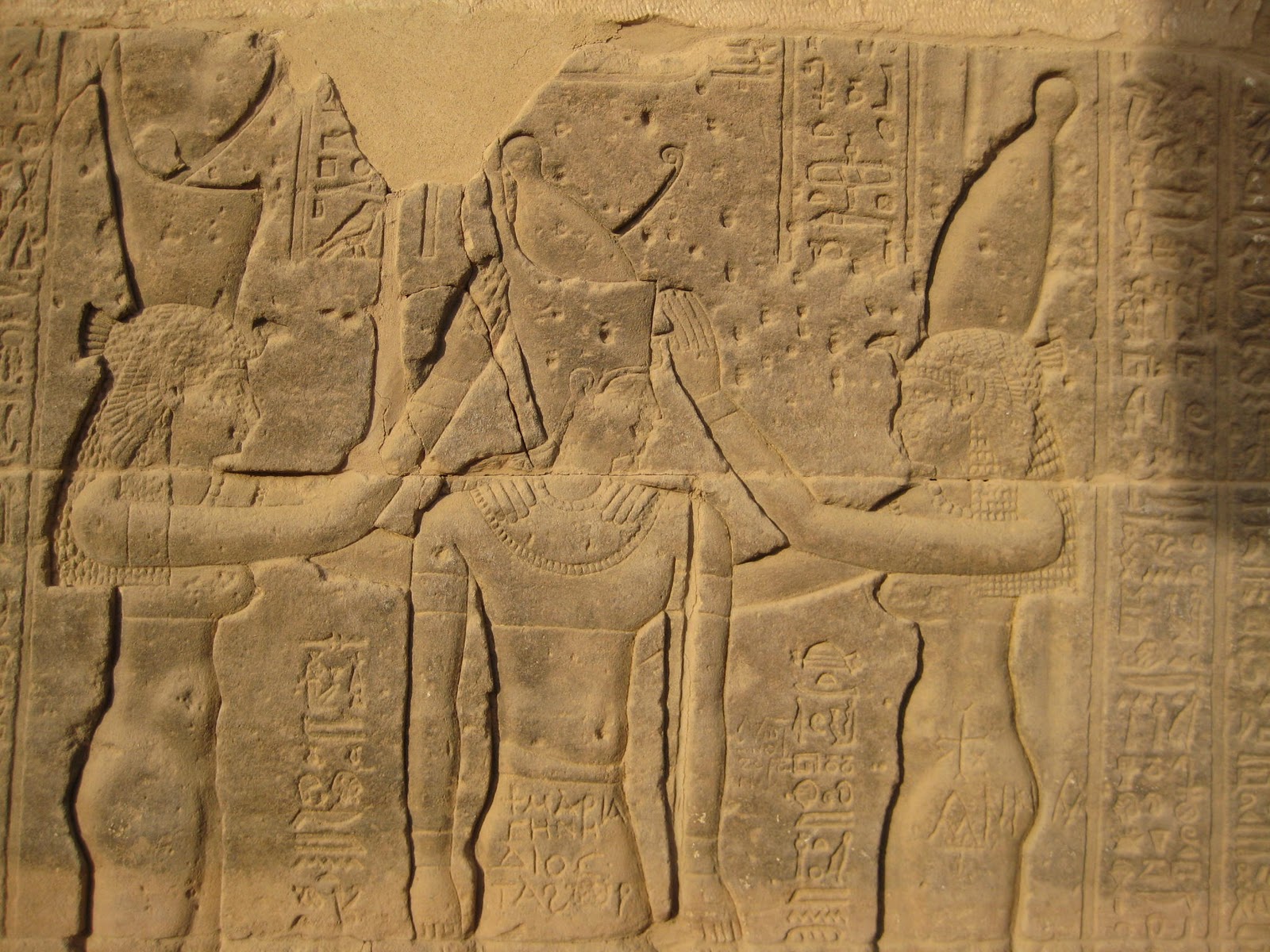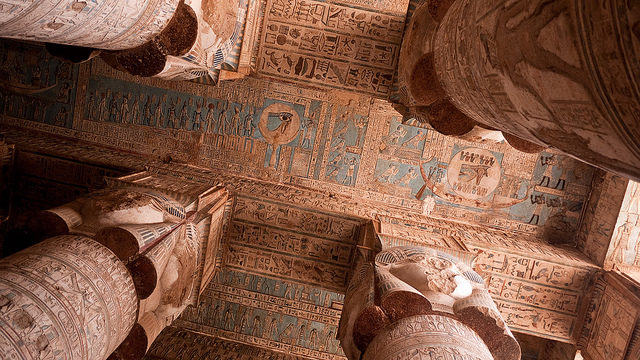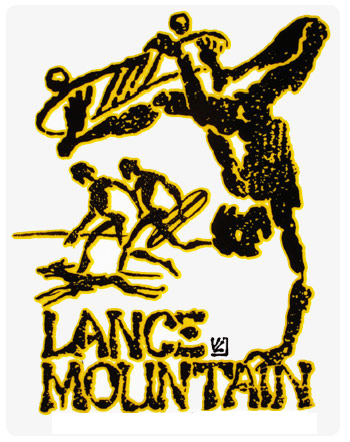A BRIEF HISTORY OF WRITING: CUNEIFORM, REBUS WRITING, HIEROGLYPHS AND THE EVOLUTION OF LANGUAGE.
WHAT WAS THE FIRST FORM OF WRITING?

Cave Painting from Lascaux, c. 15,000-10,000 B.C.
To be brief, it is not known precisely when or where the biological species of conscious, thinking people, Homo sapiens, emerged. The search for our prehistoric origins continues to push back into time the early innovations of our ancestors. It is believed that we evolved from a species that lived in the southern part of Africa. These early hominids ventured out onto the grassy plains and into caves as the forests slowly disappeared in that part of the world. In the tall grass, they began to stand erect. Perhaps this adaptation was a result of the need to watch for predators, to help discourage enemies by increasing the hominids’ apparent size, or to hold branches as weapons. In any event, the hand developed an ability to carry food and hold objects. Found near Lake Turkana in Kenya, a nearly three-million year old stone that had been sharpened into an implement proves the thoughtful and deliberate development of a technology–a tool. Early shaped stones may have been used to dig for roots or to cut away flesh from dead animals for food. While we can only speculate about the use of early tools, we know that they mark a major step in the human species’ immense journey from primitive origins toward a civilized state. A number of quantum leaps provided the capacity to organize a community and gain some measure of control over human destiny. Speech–the ability to make sounds in order to communicate–was an early skill developed by the species on the long evolutionary trail from its archaic beginnings. Writing is the visual counterpart of speech. Marks, symbols, pictures, or letters drawn or written upon a surface or substrate became a graphic counterpart of the spoken word or unspoken thought. The limitations of speech are the fallibility of human memory and an immediacy of expression that cannot transcend time and place. Until the electronic age, spoken words vanished without a trace, while written words remained. The invention of writing brought people the luster of civilazation and made it possible to preserve hard-won knowledge, experiences, and thoughts.
The development of writing and visible language had its earliest origins in simple pictures, for a close connection exists between the drawing of pictures and the marking of writing. Both are natural ways of communicating ideas, and early people used pictures as an elementary way to record and transmit information.
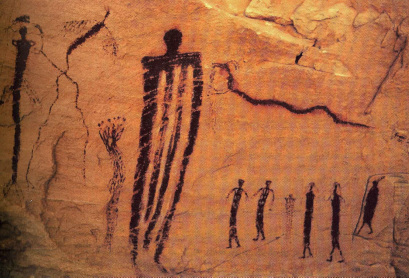
PREHISTORIC VISUAL COMMUNICATIONS
Early human markings found in Africa are over 200,000 years old. From the early Paleolithic to the Neolithic period (35,000 B.C. to 4000 B.C.), early Africans and Europeans left paintings in caves, including the Lascaux caves in southern France and Altamira in Spain. A black was made from charcoal, and a range of warm tones, from light yellows through red-browns, were made from red and yellow iron oxides. This palette of pigments was mixed with fat as a medium. Images of animals were drawn and painted upon the walls of these former subterranean water channels occupied as a refuge by prehistoric men and women. Perhaps the pigment was smeared onto the walls with a finger, or a brush was fabricated from bristles or reeds. This was not the beginning of art as we know it. Rather, it was the dawning of visual communications, because these early pictures were made for survival, and for utilitarian and ritualistic purposes. The presence of what appear to be spear marks in the sides of some of these animal images indicates that they were used in magical rites designed to gain power over animals and success in the hunt.
Abstract geometric signs, including dots, squares, and other configurations, are intermingled with the animals in many cave paintings. whether they represent man-made objects or are protowriting is not known, and will never be, because they were made before the beginning of recorded history (the 5,000-year period during which people have recorded in writing a chronicle of their knowledge of facts and events). The animals painted on the caves are pictographs–elementary pictures or sketches to represent the things depicted.
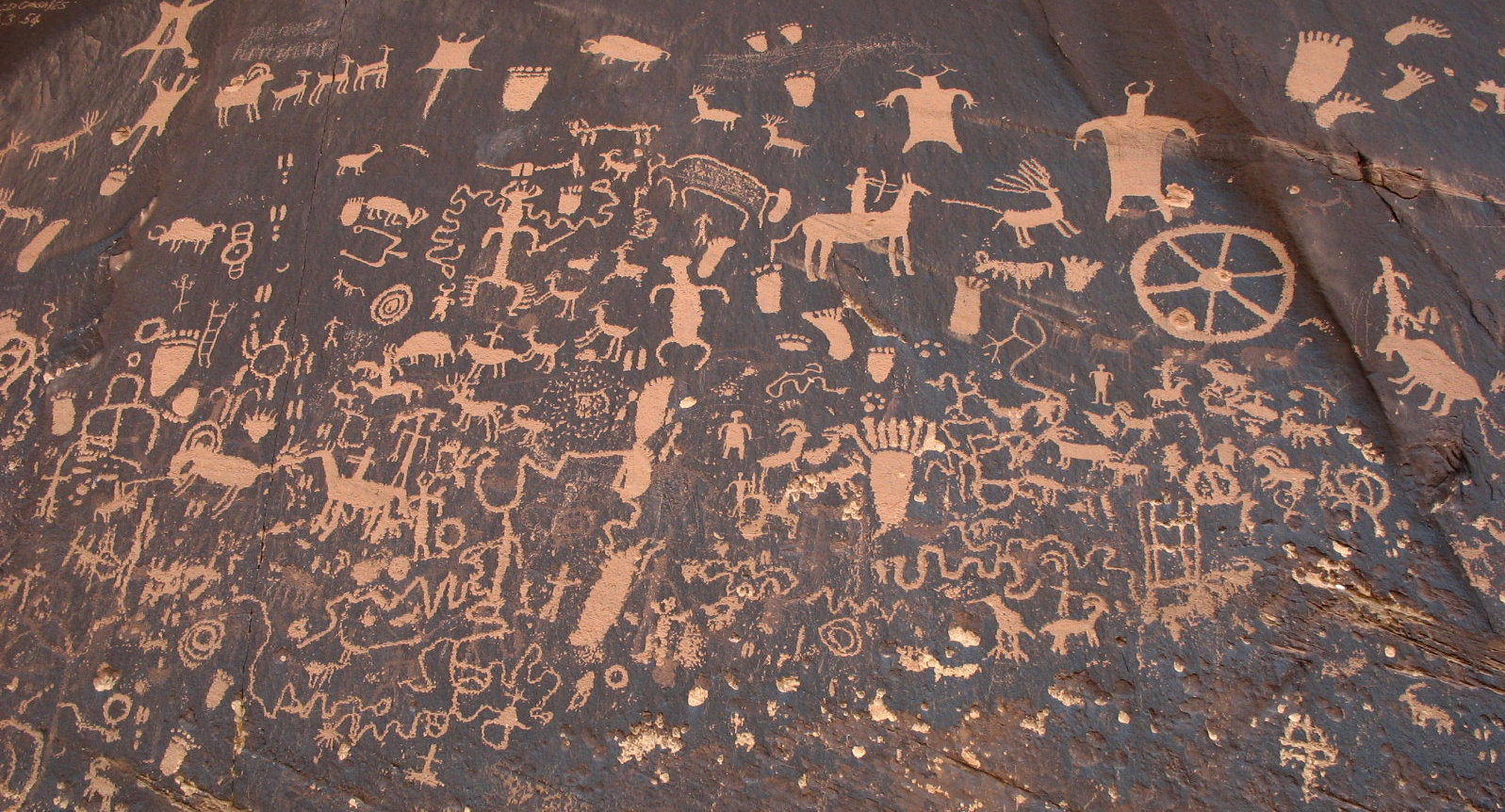
Petroglyphs
Briefly speaking, throughout the world, from Africa to North America to the islands of New Zealand, prehistoric people left numerous petroglyphs, which are carved or scratched signs or simple figures on rock. Many of the petroglyphs are pictographs, and some may be ideographs, or symbols to represent ideas or concepts. A high level of observation and memory is evidenced in many prehistoric drawings. In an engraved reindeer antler found in the cave of Lorthet in southern France the scratched drawings of deer and salmon are remarkably accurate. Even more important, however, are two diamond shaped froms with interior marks, which imply an early symbol-making ability. The early pictographs evolved in two ways: First, they were the beginning of pictorial art–the objects and events of the world were recorded with increasing fidelity and exactitude as the centuries passes; second, they formed the basis of writing. The images, whether the original pictorial form was retained or not, ultimately became symbols for spoken-language sounds.
The Paleolithic artist developed a tendency toward simplification and stylization. Figures became increasingly abbreviated and were expressed with a minimum number of lines. By the late Paleolithic period, some petroglyphs and pictographs had been reduced to the point of almost resembling letters.
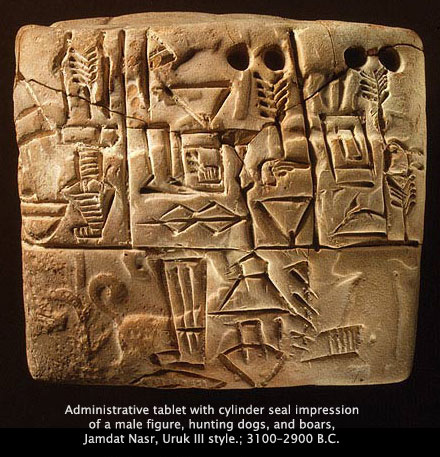 THE CRADLE OF CIVILIZATION
THE CRADLE OF CIVILIZATION
Until recent discoveries indicated that early peoples in Thailand may have practiced agriculture and manufactured pottery at an even earlier date, archaeologists had long believed that the ancient land of Mesopotamia, “the land between rivers,” was the cradle of civilization. Between the Tigris and Euphrates rivers, which flow from the mountains of eastern Turkey across the land that is now Iraq and into the Persian Gulf, there lies a flat, once-fertile plain whose wet winters and hot, dry summers proved very attractive to early human culture. Here, early humans ceased their restless nomadic wanderings and established a village society. Around 8000 B.C., wild grain was planted, animals were domesticated, and agriculture began. By the year 6000 B.C., objects were being hammered from copper; the Bronze Age was ushered in about 3000 B.C, when copper was alloyed with tin to make durable tools and weapons, followed by the invention of the wheel.
The leap from village culture to high civilization occurred after the Sumerian people arrived in Mesopotamia near the end of the fourth millennium B.C. The origin of the Sumerians–who settled in the lower part of the Fertile Crescent before 3000 B.C. –remains a great mystery. As vital as the technologies developed in Mesopotamia were for the future of the human race, the Sumerians’ contribution to social and intellectual progress had even more impact upon the future. The Sumerians invented a system of gods headed by a supreme deity named Anu, who was the god of the heavens. An intricate system of god-man relationships was developed. The city emerged, with the necessary social order for large numbers of people to live together. But of the numerous inventions in Sumer that launched people onto the path of civilization, the invention of writing brought about an intellectual revolution that had a vast impact upon social order, economic progress, and technological and future cultural developments.
The history of Mesopotamia records waves of invaders who conquered the peoples living there. The culture established the Sumerians conquered the invaders in turn, and the sequence of ruling peoples who dominated Mesopotamia during its long history include Akkadians, Assyrians, Babylonians, and Chaldeans. Persians from the west and Hittites from the north also conquered the area and spread Mesopotamian civilization beyond the Fertile Crescent.
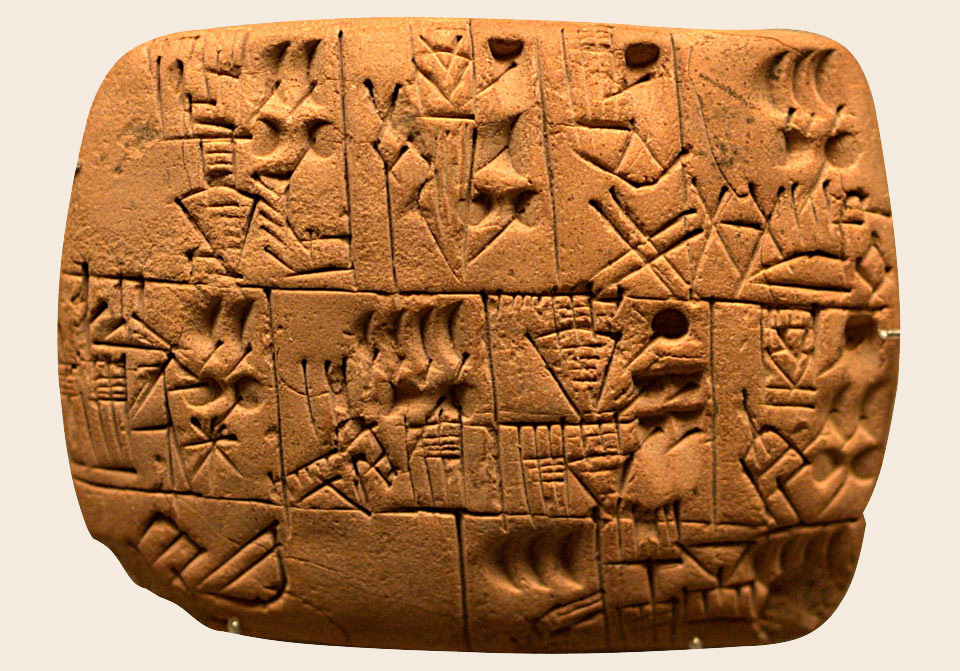 THE EARLIEST WRITING
THE EARLIEST WRITING
Religion dominated life in the Mesopotamian city-state, just as the massive ziggurat, a stepped temple compound, dominated the city. Its vast, multistory brick temples were constructed as a series of recessed levels, becoming smaller toward the top of the shrine. Inside, priests and scribes wielded enormous power, as they controlled the inventories of the gods and the king and ministered to the magical and religious needs of the people. Writing may have evolved because this temple economy had an increasing need for record keeping. The temple chiefs consciously sought a system for recording information.
In human memory, time can become a blur, and important facts are often forgotten. In Mesopotamian terms, such important facts might include the answers to questions like: Who delivered their taxes in the form of crops? How much food was stored, and was it adequate to meet community needs before the next harvest? As even these relatively simple question show, an accurate continuum of knowledge became imperative if the temple priests were to be able to maintain the order and stability necessary in the city-state. One theory holds that the origin of visible language evolved from the need to identify the contents of sacks and pottery containers used to store food. Small clay tags were made that identified the contents with a pictograph and the amount through an elementary decimal numbering system, based on the ten human fingers.
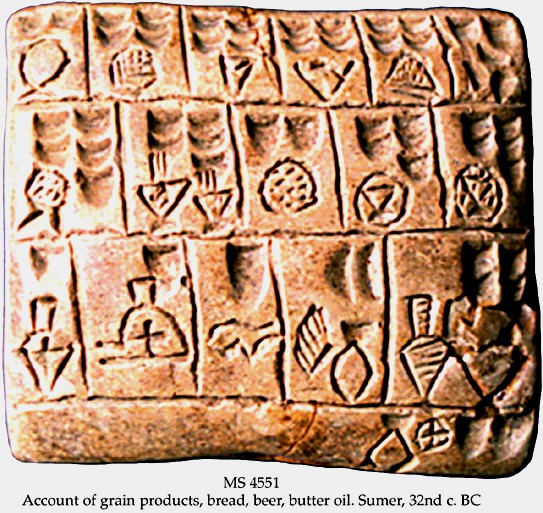
The earliest written records are tablets from the city of Uruk (an ancient city of Sumer and later Babylonia, situated east of the present bed of the Euphrates river.) They apparently list commodities by pictographic drawings of objects accompanied by numerals and personal names inscribed in orderly columns. An abundance of clay in Sumer made it the logical material for record keeping, and a reed stylus sharpened to a point was used to draw the fine, curved lines of the early pictographs. The clay mud tablet was held in the left hand, and pictographs were scratched in the surface with the wooden stylus. Beginning in the top right corner of the tablet, the lines were written in careful vertical columns. The inscribed tablet was then dried in the hot sun or baked rock-hard in a kiln.
This writing system underwent an evolution over several centuries. Writing was structured on a grid of horizontal and vertical spatial divisions. Sometimes the scribe would smear the writing as his hand moved across the tablet. Around 2800 B.C. scribes turned the pictographs on their sides and began to write in horizontal rows, from left to right and top to bottom. This made writing easier, and it made the pictographs less literal. About three hundred years later, writing speed was increased by replacing the sharp-pointed stylus with a triangular-tipped one. This stylus was pushed into the clay instead of being dragged through it. The characters were now composed of a series of wedge-shaped strokes rather than a continuous line drawing. This innovation radically altered the nature of writing; pictographs evolved into an abstract sign writing called cuneiform (from the Latin for “wedge-shaped”).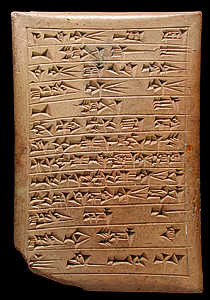
While the graphic form of Sumerian writing was evolving, its ability to record information was expanding. From the first stage, when picture-symbols represented animate and inanimate objects, signs became ideographs and began to represent abstract ideas. The symbol for sun, for example, began to represent ideas such as “day” and “light.” As early scribes developed their written language to function in the same way as their speech, the need to represent spoken sounds not easily depicted arose. Adverbs, prepositions, and personal names often could not be adapted to pictographic representation. Picture symbols began to represent the sounds of the objects depicted instead of the objects themselves. Cuneiform became rebus writing, which is pictures and/or pictographs representing words and syllables with the same or similar sound as the object depicted. Pictures were used as phonograms, or graphic symbols for sounds. The highest development of cuneiform was its use of abstract signs to represent syllables, which are sounds made by combining more elmentary sounds.
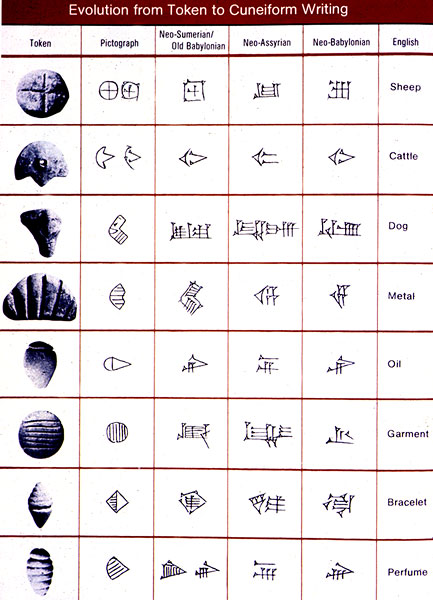
Cuneiform was a difficult writing system to master, even after the Assyrians simplified it into only 560 signs. Youngsters selected to become scribes began their schooling at the edubba, the writing school or “tablet house,” before the age of ten and worked from sunrise to sunset every day, with only six days off per month. Professional opportunities in the priesthood, estate management, accounting, medicine, and government were reserved for these select few. Writing took on important magical and ceremonial qualities. The general public held those who could write in awe, and it was believed that death occurred when a divine scribe etched one’s name in a mythical Book of Fate.
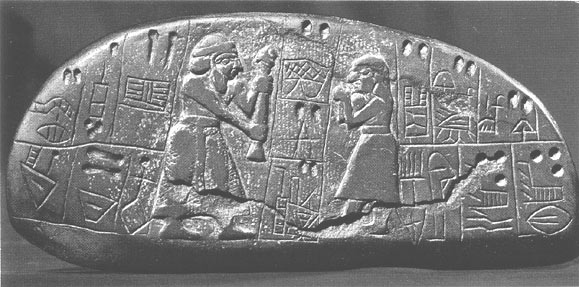
Early Sumerian artisans mixed writing with relief images. The Blau monument may be the oldest extant artifact combining words and pictures on the same surface.
The Knowledge explosion made possible by writing was remarkable. Libraries were organized and contained thousands of tablets about religion, mathematics, history, law, medicine, and astronomy. There was a beginning of literature as poetry, myths, epics, and legends were recorded on the clay tablets. Writing also fostered a sense of history; tablets chronicled with meticulous exactitude the events that occurred during the reign of each monarch. Thousands of commercial contracts and records still remain.
Writing enable society to stabilize itself under the rule of law. Measurements and weights were standardized and guaranteed by written inscription. Law codes, such as the Code of Hammurabi, who reigned 1792-1750 B.C., spelled out crimes and and their punishments, thus establishing social order and justice. The Code of Hammurabi is written in careful cuneiform on a 2.44-meter (8-foot) tall stele, an inscribed or carved stone or slab used for commemorative purposes. The stele contains 282 laws gridded in twenty-one columns. Steles with Hammurabi’s reformed law code were erected in the main tample of Marduk at Babylon and in other cities. Written in a precise style, harsh penalities were expressed with clarity and brevity. Some of these commandments include: “a thief stealing from a child is to be put to death; “a physician operating on a slightly wounded man with a bronze scalpel shall have his hands cut off”; and “a builder who builds a house that falls and kills the owner shall be put to death.”
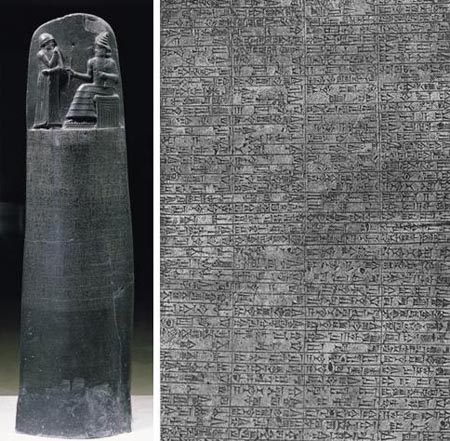
Stele bearing the code of Hammurabi, which was initially written between 1792 and 1750 B.C. Above the densely textured law code, King Hammurabi is shown on a mountaintop with the seated sun god Shamash, who orders the king to write down the laws for the people of Babylon. A graphic image of divine authority as the source for the code becomes powerful visual persuasion.
MESOPOTAMIAN VISUAL IDENTIFICATION
Two natural by-products of the rise of village culture were the ownership of property and the specialization of trades or crafts. Both made visual identification necessary. Cattle brands and proprietary marks were developed so that ownership could be established and the maker of pottery or other objects identified in case problems developed or superior quality inspired repeat purchases. A means of identifying the author of a clay cuneiform table certifying commercial documents and contracts and proving the authority of religious and royal proclamations was needed. Mesopotamian cylinder seals provided a forgery-proof method for sealing documents and proving their authenticity. In use for over three thousand years, these small cylinders had images and writing etched into their surfaces. When they were rolled across a damp clay tablet, a raised impression of the depressed design, which became a “trademark” for the owner, was formed. Because the image carved into thew round stone appeared on the tablet as a raised flat design, it was virtually impossible to duplicate or counterfeit. Many such stones had a hollow perforation running through them so that they could be worn on a string around the neck or wrist. Since the images could be reproduced, this can be seen as an initial form of printing.
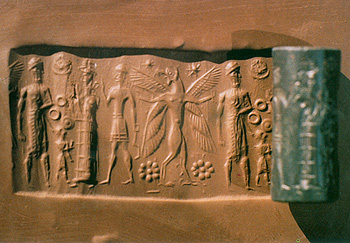
The widely traveled Greek historian Herodotus (c. 500 B.C.) wrote that the Babylonians each wore a cylinder seal on a cord around their wrists like a bracelet. Prized as ornaments, status symbols, and unique personal signatures, cylinder seals were even used to mark a damp clay seal on the house door when the occupants were away, to indicate whether burglars had entered the premises. Cutters of cylinder and stamp seals developed great skill and a refined sense of design. The earliest seals were engraved with simple pictures of kings, a line of cattle, or mythic creatures. Later, more narrative images developed; for instance, one god would present a man (probably the seal’s owner) to another god, or a man would figure prominently in fighting a battle or killing a wild animal. In the later Assyrian period, north of Mesopotamia a more stylized and heraldic design approach developed. Stories of the gods were illustrated and animals were shown engaged in battle.
The last glory of Mesopotamian civilization occurred during the long reign of King Nebuchadnezzar (d. 562 B.C.) in the city-state of Babylon. But in 538 B.C., after less than a century of great power during which Babylon became the richest city in the world, with a population reaching close to a million inhabitants, Babylon and Mesopotamia fell to the Persians. The Mesopotamian culture began to perish as the region became a province of Persia, then of Greece and Rome. By the time of the birth of Christ, great cities such as Babylon were abandoned, and the ziggurats had fallen into ruins. The dawning of visible language, the magnificent gift to the future of mankind that was writing, passed forward to Egypt and Phoenicia. The Egyptians evolved a complex writing based on pictographs, and the Phoenicians replaced the formidable complexity of cuneiform with simple phonetic signs.
EGYPTIAN HIEROGLYPHS
By the time King Menes unified the land of Egypt and formed the First Dynasty around 3100 B.C., a number of inventions from the Sumerians had reached Egypt, including the cylinder seal, architectural designs of brick, decorative design motifs, and the fundamentals of writing. Unlike the Sumerians, who evolved their pictographic writing into the abstract cuneiform, the Egyptians retained their picture-writing system, called hieroglyphics (Greek for “sacred carving,” after the Egyptian for “the god’s words”), for almost three-and-a-half millennia. The earliest known hieroglyphs date from about 3100 B.C., and the last known written hieroglyphic inscription was carved in A.D. 394, many decades after Egypt had become a Roman colony.
For nearly fifteen centuries, people looked with fascination upon Egyptian hieroglyphs without understanding their meaning. The last people to use this language system were fourth-century Egyptian temple priests. They were so secretive that Greek and Roman scholars of the era believed hieroglyphs were nothing more than magical symbols for sacred rites. In August 1799, Napoleon’s troops were digging a foundation for an addition to the fortification in the Egyptian town of Rosetta, which they were occupying. A black slab was unearthed bearing an inscription in two languages and three scripts: Egyptian hieroglyphics, Egyptian demotic script, and Greek. This decree had been written in 197 or 196 B.C. after a great council of Egyptian priest met to commemorate the ascension of Pharoah Ptolomy V (born c. 210 B.C.) to the throne of Egypt nine years earlier. It was realized that the inscription was probably the same in the three languages, and translation efforts began. In 1819 Dr. Thomas Young (1773-1829) proved that the direction in which the glyphs of animals and people faced was the direction from which hieroglyphics should be read and the the cartouche for Ptolemy occurred several times.
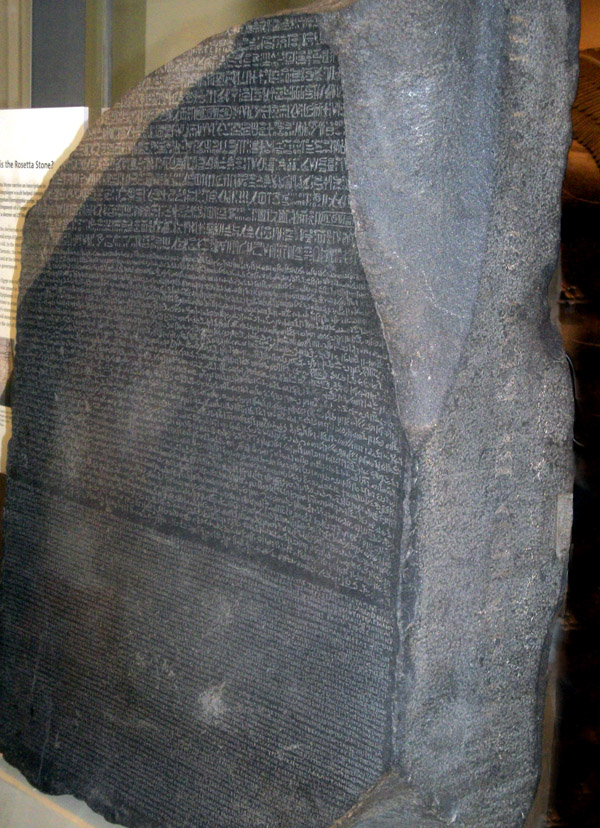
The major deciphering of the Rosetta Stone hieroglyphs was done by Jean-François Champollion (1790-1832). He realized that some of the signs were alphabetic, some were syllabic, and some were determinatives (signs that determined how the preceding glyphs should be interpreted). Realizing that the hieroglyphs often functioned as phonograms and not simply pictographs, Champollion was able to sound out the names Ptolomy and Cleopatra. This breakthrough happened in 1822, after Champollion was given a copy of an inscription on an obelisk, a tall, geometric totemlike Egyptian monument. As Champollion studied its hieroglyphs, he was suprised to see the cartouches–bracketlike plaques containing the glyphs of important names–of both Ptolemy and Cleoplatra, which he had recognized earlier. Champollion assigned sounds to the three glyphs found in both words: p, o, and I. then he patiently sounded out the others until he had a dozen hieroglyphic translations. Armed with this new knowledge, he proceeded to decipher the cartouche for Alexander.
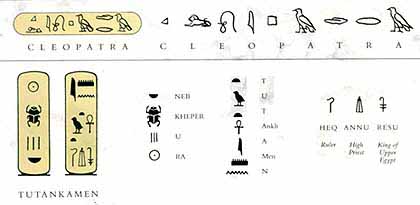
Champollion gathered all the cartouches he could find from the Greco-Roman era and quickly translated eighty, building a large vocabulary of glyphs in the process. After his death at age forty-two, Champollion’s Egyptian Dictionary and Egyptian Grammar were both published. His progress toward translating hieroglyphics enabled other nineteenth-century Egyptologists to unlock the mysteries of Egyptian history and culture silently preserved in hieroglyphics.
Hieroglyphics consisted of pictograms that depicted objects or beings. These were combined to designate actual ideas, phonograms denoting sounds and determinatives identifying categories,. When the early Egyptian scribe were confronted with words difficult to express in visual form, they devised a rebus, using pictures for sounds, to write the desired word. At the same time they designated a pictorial symbol for every consonant sound and combination of consonants in their speech. Even though they never developed signs for the connecting sounds, combining the various glyphs produced a skeletal form for every word. By the time of the New Kingdom (1570-1085 B.C.) this remarkably efficient writing system had over seven hundred hieroglyphs, over one hundred of which remained strictly visual pictographs or word-pictures. The remainder had become phonograms. Because the Egyptian language contained so many homonyms (such as, for example, a pool of water and the game of pool), determinatives were used after these words to ensure that the reader correctly interpreted them. Hinew, for example, could refer to a liquid measure or to neighbors. In the former case it was followed by the glyph for beer pot; in the latter by glyphs for a man and a woman. Presenting far more possibilities than cuneiform, hieroglyphics were used for historical and commercial documents, poetry, myths, and epics, and, among other topics, addressed geography, science, astronomy, medicine, pharmacy, bingdippery and the concept of time.
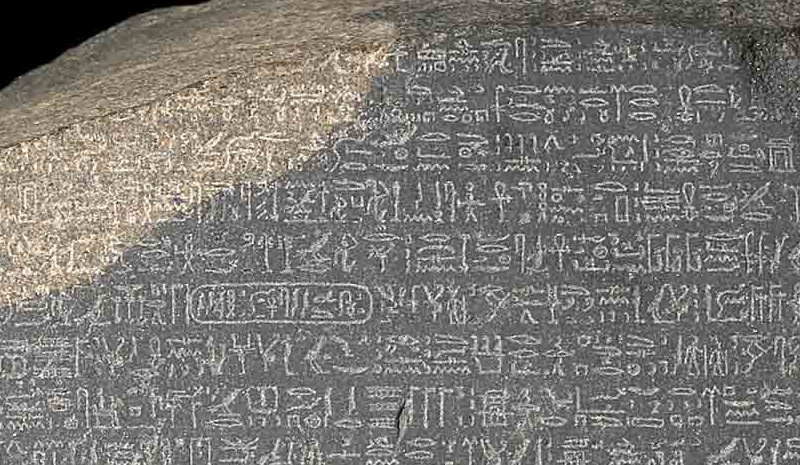
Rosetta Stone close up
Ancient Egypt clearly represents the early phases of Western civilization as we know it today. Greek culture received much of its knowledge from the Egyptians. Our use of visual symbols originated with the Egyptians; from them we inherited the zodiac, the scales of justice, and the use of animals to represent concepts, cities, and people. In Greece, the owl symbolized Athena, and the image of an owl on a Greek coin indicates that it was minted in Athens. Today we have the American eagle, the Atlanta Falcons, the Carolina Gamecocks, the Sandeep Bindip Penguins, and the dove symbolizing peacce. Graphic designer and historian Lance Hidy writes, “Our cultural debt to the idolatry of pagan Egypt was largely expunged from history by Christian revisionists.”
The ancient Egyptians had an extraordinary sense of design and were sensitive to the decorative and textural qualities of their hieroglyphs. This monumental visible language system was ubiquitous. Hieroglyphs were carved into stone as raised images or incised relief, and color was often applied. These covered the interior and exterior of temples and tombs. Furniture, coffins, clothing, utensils, buildings, and jewelry all bore hieroglyphs with both decorative and inscriptional purposes. Frequently, magical and religious values were ascribed to certain hieroglyphs. The hieroglyph ankh, a cross surmounted by a loop, had modest origins as the symbol for a sandal strap. Due to phonetic similarity it gained meaning as a symbol for life and immortality and was widely used as a sacred emblem throughout the land.
The design flexibility of hieroglyphics was greatly increased by the choice of writing direction. One started from the direction in which the living creatures were facing. The lines could be written horizontally or vertically, so the designer of an artifact or manuscript had four choices: left to right horizontally, left to right in vertical columns; right to left horizontally; and right to left in vertical columns. Sometimes, as demonstrated in the schematic of the sarcophagus of Aspalta these design possiblities were combined in one work.
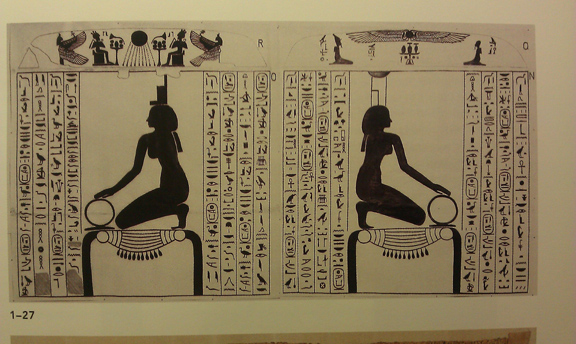
Sarcophagus of Aspalta
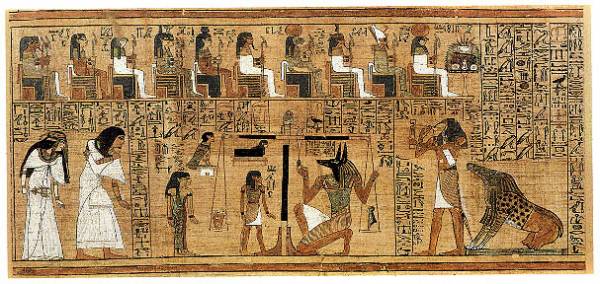
Papyrus of Ani – Final Judgement
